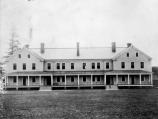In late 2016, after over a year of work, the rehabilitation of Army Barracks Building 987 at Fort Vancouver National Historic Site was completed. Work began on the 1906 classical revival-style building in the summer of 2015. The building was originally constructed by the U.S. Army to function as a double infantry barracks, and most recently served as the headquarters of the U.S. Army Reserve's 104th Division up until 2010. The building is being adaptively reused to function as office space, and beginning in early 2017, it will become the headquarters of the U.S. Forest Service's Gifford Pinchot National Forest.
In 2012, the U.S. Army left Vancouver Barracks and transferred the buildings of the eastern and southern portions of the reserve to the National Park Service through the Base Realignment and Closure Act (BRAC). The National Park Service is honored to interpret the military history of Vancouver Barracks, and is committed to preserving these buildings for future generations.
Historic Preservation & Adaptive Reuse
The National Park Service is a proud proponent of historic preservation, and the adaptive reuse of existing buildings on federal lands. As stated in the 1966 National Historic Preservation Act:
"The preservation of [our] irreplaceable heritage is in the public interest so that its vital legacy of cultural, educational, aesthetic, inspirational, economic, and energy benefits will be maintained and enriched for future generations of Americans."
Adaptive reuse refers to the process of reusing an old site or building for a purpose other than that for which it was built or designed. Adaptive reuse may include multiple preservation treatment approaches. In addition to social and economic benefits, adaptive reuse of buildings, is a great environmental practice, as it makes use of historic structures, retains aspects of the original building, and puts the building to use for modern needs. As architect Carl Elefante once said, "The greenest building is one that's already built."
Work completed for the adaptive reuse of Building 987 included both interior and exterior modifications and restoration of certain architectural elements. Modern interior walls and other recent additions from the period of U.S. Army office space were removed, leaving the primary original shell of the building. This created a more open, and historically representative, layout of the building.
Original and historically significant architectural elements were restored. In addition to restoration, the building had a seismic retrofit put in place, and was made to be ADA accessible on both the interior and exterior, with the installation of an elevator and an exterior lift.
A Detailed Restoration
The primary contractor of the project, Pacific Tech Construction of Kelso, Washington, worked with the National Park Service to handle the sensitive and historic nature of the building and site.
In addition to modern updates to the building, many of the original significant architectural elements were restored. The original windows were removed, stripped of all paint, and restored to working order at a local historic window restoration business. They were reinstalled with new cords, weather stripping, and interior storm slips. Doors that could be re-used were removed, stripped of all paint, repaired, and re-painted. The doors were then re-installed in their original locations and received all new hardware.
Layers of modern carpeting and vinyl flooring covering the building's original wooden floors were removed. The original floors were mostly maple; the east wing was floored in fir, and the stairs and previous infill repairs were oak. Once the modern flooring was removed, the original wood was sanded and refinished with a clear coat.
Porch columns and railings were removed, and the many layers of paint were scraped off. The columns were restored as needed, repainted, finished, and placed back in their original locations.
To allow for the installation of seismic support and an elevator, some of the building's tin ceiling tiles were carefully removed, catalogued and stored. The ceiling tiles were treated for lead abatement, then the majority were replaced in their original locations.
The large sandstone blocks of the building's foundation were cleaned by low pressure washing. The building's support posts had their paint removed with a gentle paint stripper as not to damage the stone. Areas of damage or holes were patched. the care and preservation of these important architectural elements will ensure their continued function and beauty for years into the future.
The successful rehabilitation and adaptive reuse of Army Barracks Building 987 leads the way for future restoration and preservation of Vancouver Barracks' buildings, and for opportunities to increase community partnerships through leasing.
Last updated: December 22, 2017

